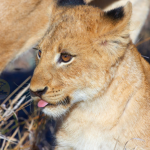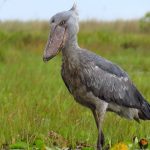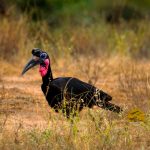The African Grey Hornbill: Uganda’s Unique Avian Treasure.
With its unmistakable profile and musical calls, the African Grey Hornbill is one of the most charming avifauna denizens of Uganda. From open savannahs to open broadleaf woodlands, this bird never fails to fascinate birdwatchers and nature lovers. Indeed, with its varying topography and different ecosystems, Uganda can boast as a perfect haven for this majestic creature.
Appearance and Behaviour.
The African Grey Hornbill is unmistakable because of its striking features. It is essentially grey, with a long curved black bill surmounted by a prominent casque-a distinctive hornbill feature. The bill of the male is larger and more deeply casqued, while that of the female is smaller and less ornate.
They have broad, round wings that make them fly deftly, with a white stripe down the primary flight feathers. And the long tail feathers add grace to their features; that makes them a hot subject of photography.
With loud, chuckling calls, the African Greys often announce their presence well before they come into view. It is a call for communication and a call for mating; the echoing through Uganda’s forests and savannas underpins the vibrancy of its natural landscapes.
Diet and Feeding Habits.
African Grey Hornbills are opportunistic omnivores, consuming fruits, insects, small reptiles, and even small mammals. They especially favor figs and other wild fruits, and their feeding on these fruits has an important role in seed dispersal, hence assisting in the regeneration of the forest. The diet becomes rich in proteins during the breeding season, with most of the insects consumed for nourishing the chicks.
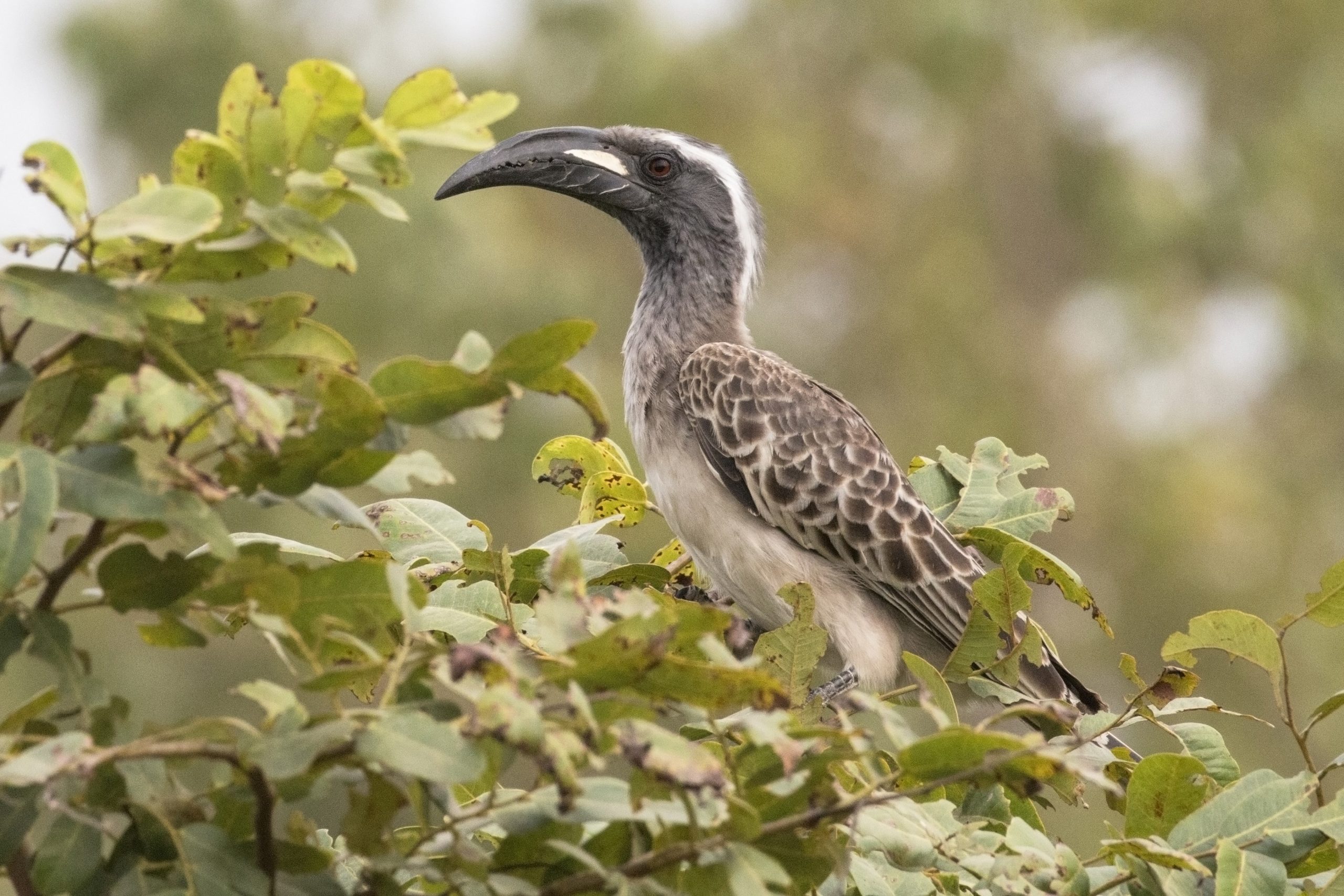
Breeding and Nesting Behaviours.
The breeding of the African Grey Hornbill is considered one of the fascinating spectacles in nature. Nesting behavior in birds is unique; close cooperation from mates is necessary:
Nesting Habits: Eggs are laid by the female inside natural tree hollows. For protection against predation, it covers the entrance of the hollows containing the eggs and young with a paste prepared with mud, droppings, and food, which has a small opening.
Laying eggs: Usually, she lays 2 to 6 eggs, which incubates for almost 25 to 30 days. During this period the male has to work incessantly in delivering food through the narrow slit.
Chick development: Once the chicks grow big enough to fledge the female breaks out of the sealed nest, and the family continues to feed together till the chicks have become fully independent.
This nesting strategy protects the helpless eggs and chicks and aids in the survival of the species.
Lifespan of the African Grey Hornbill.
The African Grey Hornbill is relatively long-lived for such a medium-sized bird and commonly reaches ages of between 10 to 20 years in the wild. Factors influencing their lifespan include predation, conditions that affect food supply, and suitable habitat. In captivity, it may reach 25 years, as most threats are eliminated.
Their ability to adapt to various living habitats and the cooperative breeding behaviors increase their survivorship potential by great margins, hence becoming resilient inhabitants in all different landscapes in Africa.

Where to Spot African Grey Hornbill in Uganda?
If you’re looking to sight the African Grey Hornbill, then Uganda’s protected areas have some of the best possibilities. The premium spots in this respect include:
Murchison Falls National Park: The expansive savannahs and riverine woodlands of Murchison Falls National Park form superb habitat conditions for the African Grey Hornbill. Combine birding with a boat cruise on the Nile to make it all wholly absorbing.
Queen Elizabeth National Park: This park boasts rich biodiversity and serves as a hotspot for birdwatching. Visitors can often spot the African Grey Hornbill along the Mweya Peninsula and the Kasenyi Plains.
Lake Mburo National Park: This park is a birder’s paradise, with over 350 species recorded here. The open woodlands and acacia forests make it an excellent spot to observe these hornbills.
Kidepo Valley National Park: Remote yet rewarding, Kidepo offers a stunning backdrop of rugged landscape and diverse birdlife, including the African Grey Hornbill.
Conservation and Cultural Significance
Hornbills are ecosystem seed dispersers, but this and many other wildlife species continue to face threats of habitat loss and human activity. Due to the conservation efforts within Uganda, tourists will enjoy birds in their natural habitat for years to come.
In some African cultures, people consider hornbill birds auspicious and include them in almost all traditional folklores, making them an important part of the local heritage.

Planning a Birdwatching Adventure in Uganda?
For a well-planned visit to view the African Grey Hornbill and many other amazing species in Uganda, one needs expert guidance. And that is where Arcadia Safaris comes in.
Why Choose Arcadia Safaris? Arcadia Safaris specializes in customized birdwatching tours, offering unparalleled expertise in Uganda’s rich avian life. From arranging skilled guides to ensuring your itinerary covers key birding hotspots, they provide a seamless and unforgettable experience.
Special Recommendations: Let Arcadia Safaris combine your birding trip with other activities such as game drives, cultural tours, and nature walks. They have packages for both the avid birder and the curious traveler.
Best time for a Birding Tour in Uganda.
The best time for birding in Uganda is the dry seasons, which fall between December and February and June to August. This time provides favorable conditions, and the trails will be more visible, hence easy to use, especially in Bwindi Impenetrable Forest and Mabamba Wetlands. Migratory birds are present from November to April and add to the list of many species to look out for. However, Uganda has a generally favorable climate throughout the year and, therefore, can be visited any time for bird-watching activities.
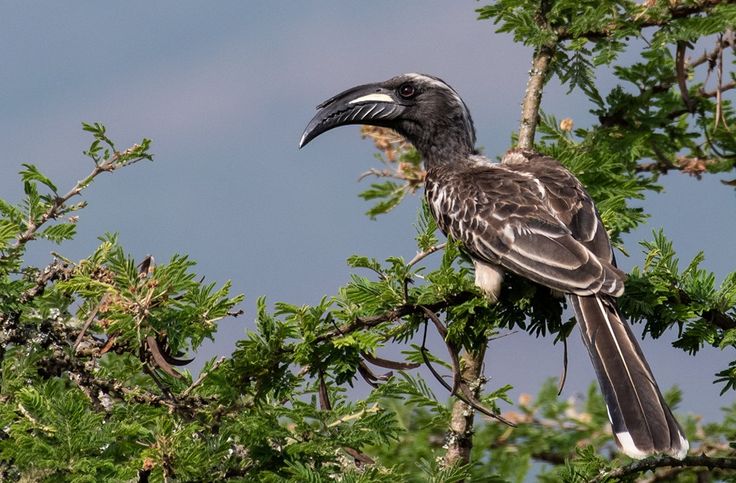
Our Remarkable Uganda Birding Tours.
Take a journey into some of the most memorable landscapes of Uganda with our incomparable birding tours. Come for an experience in this paradise for bird enthusiasts, with over 1,000 species of birds, some of which are rare and therefore endemic treasures. From moist forests to wetlands and open savannahs, our guided tours will ensure a unique and breathtaking experience in the Pearl of Africa. Below are some of our best birding tours we offer in Uganda.
21 Days Birding Uganda and Gorilla Trekking Safari
18 Days Birding Tour with Gorilla Trekking
10 Day Birding Uganda and Game Drives
3 Day Mabamba Shoebill and Birding Safari
Remarks on African Grey Hornbill in Uganda.
The African Grey Hornbill is a testament to the richness of Uganda’s avian diversity. This makes the species a sight not to miss on any tour across the Pearl of Africa due to its striking sight, unique behaviors, and crucial ecological role it plays. Guided by Arcadia Safaris into the breath-taking landscape where these birds thrive, you are taken on an excellent birding adventure. To the enthusiastic birder or curious traveler, the African Grey Hornbill promises one thing-it will leave you marveled at nature’s magic.




